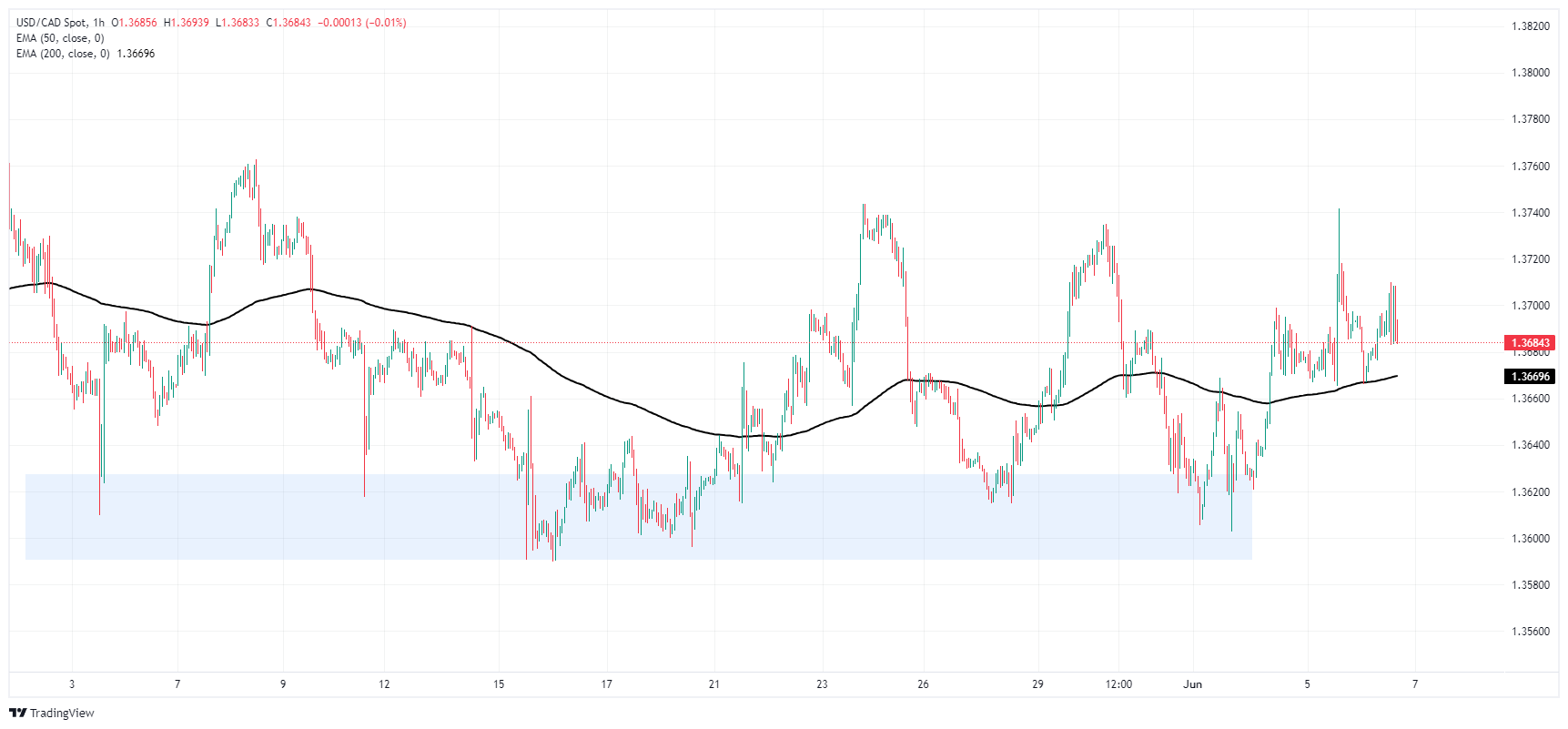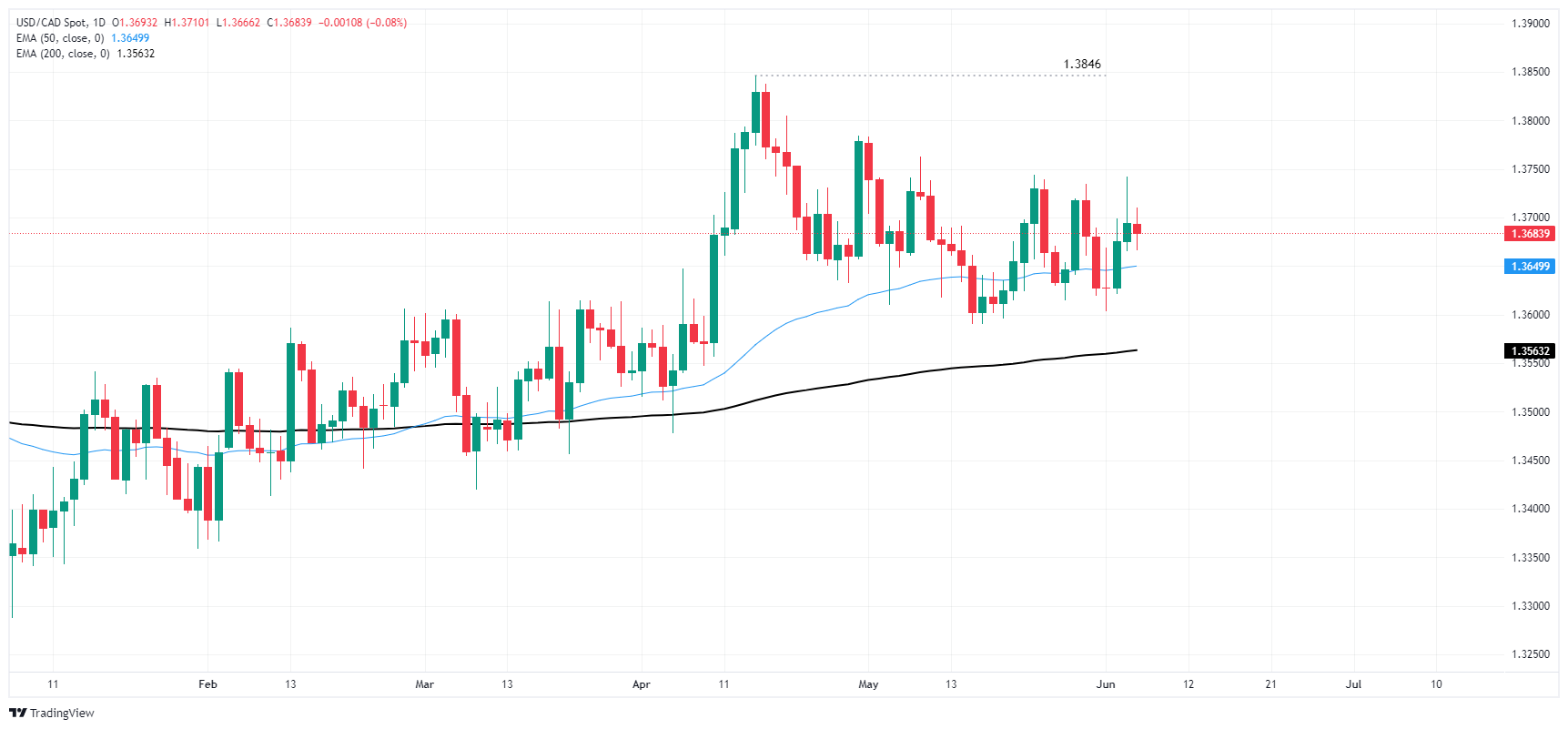- Phân tích
- Tin tức và các công cụ
- Tin tức thị trường
- Canadian Dollar flattens on Thursday as markets await US NFP
Canadian Dollar flattens on Thursday as markets await US NFP
- Canadian Dollar treads water as investors buckle down ahead of Friday data.
- Canada will bring wages and labor change to the table on Friday.
- US NFP remains the capstone to the week’s data.
The Canadian Dollar (CAD) settled into a holding pattern on Thursday as markets batten down the hatches ahead of Friday’s key labor data from both the US and Canada. Investors are still leaning into bets of a September rate cut from the US Federal Reserve (Fed), but chances of a push-out to November are still on the cards.
Canada will drop its latest wage growth and labor change figures on Friday, but the releases will be dwarfed by the latest US Nonfarm Payrolls (NFP) data dump. The Canadian Unemployment Rate is expected to tick higher in May, and new Canadian hirings are forecast to recede. On the US side, markets have trimmed expectations of net job additions but still expect a higher print.
Daily digest market movers: Canadian PMIs slip back, US jobless claims rise further
- Canada’s Ivey Purchasing Managers Index (PMI) fell to 52.0 in May on a seasonally-adjusted basis, a sharp pullback from the previous two-year high of 63.0. Median market forecasts had expected an uptick to 65.0.
- US Initial Jobless Claims rose to 229K in the week ended May 31, up from the previous week’s revised 221K. The print missed forecasts of 220K.
- US Labor Costs also eased in the first quarter, growing by 4.0% versus the forecasted uptick to 4.9% from the previous 4.7%.
- With labor costs and activity easing, market hopes for a September rate cut from the Fed are holding on the high side. According to the CME’s FedWatch Tool, rate markets are pricing in around 70% odds of at least a quarter-point trim when the Federal Open Market Committee (FOMC) announces its latest rate call on September 18.
- US NFP looms large on Friday, with median market forecasts now calling for 185K in net new jobs in May versus the previous print of 175K. US Average Hourly Earnings are also expected to tick higher to 0.3% MoM compared to the previous 0.2%.
Canadian Dollar PRICE Today
The table below shows the percentage change of Canadian Dollar (CAD) against listed major currencies today. Canadian Dollar was the strongest against the British Pound.
| USD | EUR | GBP | JPY | CAD | AUD | NZD | CHF | |
|---|---|---|---|---|---|---|---|---|
| USD | -0.11% | 0.05% | -0.17% | -0.07% | -0.20% | -0.01% | -0.22% | |
| EUR | 0.11% | 0.17% | -0.07% | 0.06% | -0.11% | 0.07% | -0.10% | |
| GBP | -0.05% | -0.17% | -0.24% | -0.12% | -0.29% | -0.11% | -0.26% | |
| JPY | 0.17% | 0.07% | 0.24% | 0.12% | -0.02% | 0.10% | -0.03% | |
| CAD | 0.07% | -0.06% | 0.12% | -0.12% | -0.14% | 0.07% | -0.14% | |
| AUD | 0.20% | 0.11% | 0.29% | 0.02% | 0.14% | 0.18% | -0.02% | |
| NZD | 0.00% | -0.07% | 0.11% | -0.10% | -0.07% | -0.18% | -0.18% | |
| CHF | 0.22% | 0.10% | 0.26% | 0.03% | 0.14% | 0.02% | 0.18% |
The heat map shows percentage changes of major currencies against each other. The base currency is picked from the left column, while the quote currency is picked from the top row. For example, if you pick the Canadian Dollar from the left column and move along the horizontal line to the US Dollar, the percentage change displayed in the box will represent CAD (base)/USD (quote).
Technical analysis: Canadian Dollar pulls into the midrange as momentum drains
The Canadian Dollar (CAD) is easing into the middle on Thursday, trading within a tenth of a percent against the majority of its major currency peers. Performance is likewise mixed, with the CAD in the green against a little over half of its counterparts in thin trading.
USD/CAD is seeing chart churn on Thursday, testing the 1.3700 handle in tepid action. The pair is holding on the high side of a demand zone between 1.3630 and 1.3590, but topside momentum remains limited, keeping levels beyond 1.3700 out of reach.
Daily candlesticks continue to tread water within touch range of the 50-day Exponential Moving Average (EMA) at 1.3650. Directional momentum has receded ever since USD/CAD fell away from 2024’s peak bids at 1.3846, but long-term technicals still favor the bulls as the 200-day EMA rises into 1.3560 to put a price floor underneath any bearish declines.
USD/CAD hourly chart
USD/CAD daily chart
Canadian Dollar FAQs
The key factors driving the Canadian Dollar (CAD) are the level of interest rates set by the Bank of Canada (BoC), the price of Oil, Canada’s largest export, the health of its economy, inflation and the Trade Balance, which is the difference between the value of Canada’s exports versus its imports. Other factors include market sentiment – whether investors are taking on more risky assets (risk-on) or seeking safe-havens (risk-off) – with risk-on being CAD-positive. As its largest trading partner, the health of the US economy is also a key factor influencing the Canadian Dollar.
The Bank of Canada (BoC) has a significant influence on the Canadian Dollar by setting the level of interest rates that banks can lend to one another. This influences the level of interest rates for everyone. The main goal of the BoC is to maintain inflation at 1-3% by adjusting interest rates up or down. Relatively higher interest rates tend to be positive for the CAD. The Bank of Canada can also use quantitative easing and tightening to influence credit conditions, with the former CAD-negative and the latter CAD-positive.
The price of Oil is a key factor impacting the value of the Canadian Dollar. Petroleum is Canada’s biggest export, so Oil price tends to have an immediate impact on the CAD value. Generally, if Oil price rises CAD also goes up, as aggregate demand for the currency increases. The opposite is the case if the price of Oil falls. Higher Oil prices also tend to result in a greater likelihood of a positive Trade Balance, which is also supportive of the CAD.
While inflation had always traditionally been thought of as a negative factor for a currency since it lowers the value of money, the opposite has actually been the case in modern times with the relaxation of cross-border capital controls. Higher inflation tends to lead central banks to put up interest rates which attracts more capital inflows from global investors seeking a lucrative place to keep their money. This increases demand for the local currency, which in Canada’s case is the Canadian Dollar.
Macroeconomic data releases gauge the health of the economy and can have an impact on the Canadian Dollar. Indicators such as GDP, Manufacturing and Services PMIs, employment, and consumer sentiment surveys can all influence the direction of the CAD. A strong economy is good for the Canadian Dollar. Not only does it attract more foreign investment but it may encourage the Bank of Canada to put up interest rates, leading to a stronger currency. If economic data is weak, however, the CAD is likely to fall.
© 2000-2024. Bản quyền Teletrade.
Trang web này được quản lý bởi Teletrade D.J. LLC 2351 LLC 2022 (Euro House, Richmond Hill Road, Kingstown, VC0100, St. Vincent and the Grenadines).
Thông tin trên trang web không phải là cơ sở để đưa ra quyết định đầu tư và chỉ được cung cấp cho mục đích làm quen.
Giao dịch trên thị trường tài chính (đặc biệt là giao dịch sử dụng các công cụ biên) mở ra những cơ hội lớn và tạo điều kiện cho các nhà đầu tư sẵn sàng mạo hiểm để thu lợi nhuận, tuy nhiên nó mang trong mình nguy cơ rủi ro khá cao. Chính vì vậy trước khi tiến hành giao dịch cần phải xem xét mọi mặt vấn đề chấp nhận tiến hành giao dịch cụ thể xét theo quan điểm của nguồn lực tài chính sẵn có và mức độ am hiểu thị trường tài chính.
Sử dụng thông tin: sử dụng toàn bộ hay riêng biệt các dữ liệu trên trang web của công ty TeleTrade như một nguồn cung cấp thông tin nhất định. Việc sử dụng tư liệu từ trang web cần kèm theo liên kết đến trang teletrade.vn. Việc tự động thu thập số liệu cũng như thông tin từ trang web TeleTrade đều không được phép.
Xin vui lòng liên hệ với pr@teletrade.global nếu có câu hỏi.















